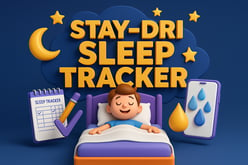By Dr. Tiffani S. Bacon, PT, DPT — Founder, The Bladder Breakthrough™
What’s Sleep Got to Do With Bladder Control?
If you thought sleep was just about recharging your child’s energy, think again. While your little one is off in dreamland, there’s a fierce backstage production happening—where brain waves, hormones, and muscle rhythms are all working to keep their bed dry. The bladder and the brain are constantly whispering to each other during sleep—and sometimes… they don’t quite agree on the plan.
Turns out, the relationship between sleep and bladder control isn’t just close—it’s codependent. And when that relationship breaks down? That’s when nighttime accidents, urgency, and even overactive bladder behaviors sneak in.
Let’s unpack this wild, under-the-covers connection so you can better understand what’s going on in your child’s body—and how to support it.
The Brain-Bladder Sleep Connection: Who’s Actually in Charge?
Deep in the brain, a pathway from the forebrain to the brainstem plays quarterback for nighttime bladder control. When that connection is strong and stable, your child’s brain can suppress the urge to urinate during sleep. When it’s not? Enter stage left: bedwetting.
Neuroendocrine stress (think: chronic worry, poor sleep, or even subtle inflammation) throws a wrench in that system—disrupting signals and creating what’s called overactive bladder syndrome. Yes, even kids can experience this.
⏰ Circadian Rhythm = Your Bladder’s Internal Clock
Here’s the mic-drop moment: your child’s bladder has its own internal clock. It literally follows a circadian rhythm. That means if your child’s sleep schedule is erratic, or if they’re exposed to lots of artificial light at night (👋 screen time), their bladder may not get the memo that it’s not time to go.
Poor circadian rhythm = poor bladder compliance = more nighttime voiding.
💡Tip: Consistent bedtime, dim lighting at night, and predictable routines can help reset your child’s bladder-brain clock.
Sleep Stages & Bladder Battles: REM vs. NREM
Here’s where it gets fascinating (and maybe a little nerdy—in the best way).
-
REM sleep (when most dreaming happens) influences hormone secretion like vasopressin, which helps the body retain water. Disrupted REM = more nighttime urine production.
-
NREM sleep (the deeper, more restorative stuff) is when bladder signals should be “quieted.” If it’s fragmented or shallow? The bladder muscles—especially the detrusor muscle—may misfire.
Research even suggests that sleep spindles, special brainwave bursts during sleep, might be tied to how the detrusor muscle stays relaxed. If your child struggles with poor sleep quality, this intricate muscle-bladder harmony can easily unravel.
Sleep Disorders = Bladder Disruptors
If your child snores, is overweight, or shows signs of obstructive sleep apnea (OSA)—you might be looking at one of the most underestimated causes of bedwetting. OSA disturbs sleep architecture, messes with oxygen levels, and throws hormone release completely off course—leading to more urine at night, and fewer opportunities to wake up and respond to the urge.
Age, Genes & The Family Bladder Tree
It’s not just about sleep and stress. Genetics play a major role.
Some kids are simply wired to be deep sleepers with slower maturing brain-bladder pathways. If you, your partner, or Grandma struggled with enuresis as children—your kiddo may be part of the same biological bedtime story.
Couple that with the natural age-related changes in sleep (like delayed melatonin release during puberty), and it’s no wonder incontinence can spike in tween years, even if the child was previously dry.
What Can You Actually Do About It?
Here’s the real talk: this isn’t about laziness, poor parenting, or lack of motivation. Your child’s body is telling a complex neurological, hormonal, and circadian story.
Here’s how to support them:
- Respect the rhythm: Keep a regular sleep-wake cycle—even on weekends.
- Screen off early: Reduce blue light exposure at least an hour before bed.
- Address sleep quality: If snoring, mouth breathing, or daytime fatigue is present, talk to your pediatrician about a sleep study.
- Hydrate smart: Frontload fluids early in the day. Reduce liquids 1–2 hours before bed.
- Calm the nervous system: Use bedtime breathing exercises, white noise, or gentle bedtime routines to reduce cortisol levels.
- Track patterns: Use a printable tracker (like the one in The Bladder Breakthrough™ kit) to identify trends.
💡 Final Thought: It’s Not “Just” Bedwetting—It’s a Window into the Brain
When your child wets the bed, it’s not a character flaw—it’s a physiological flare-up. Something’s misfiring between their bladder and their brain during sleep. But now, you’re armed with a roadmap to decode that mystery.
You’re not just helping them stay dry—you’re helping them sleep deeper, wake brighter, and feel more in control of their body.
You’ve got this, and you’re not alone. And here at The Bladder Breakthrough™, we’re here to walk (and sleep) alongside you.
🔁 Want to Dive Deeper?
Check out our FREE Bladder-Sleep Checklist & download the “Stay-Dri Sleep Tracker” to start decoding your child’s sleep-bladder story tonight.
👾 Bonus: Our new Breathe Buddy™ gaming app teaches kids these concepts in a totally fun, gamified way.
👉 Check out our smoothing gaming app
👉 Get the Checklist!
🧠 References
For the science-loving parents and clinicians in the room—click here to view the full citation list.

